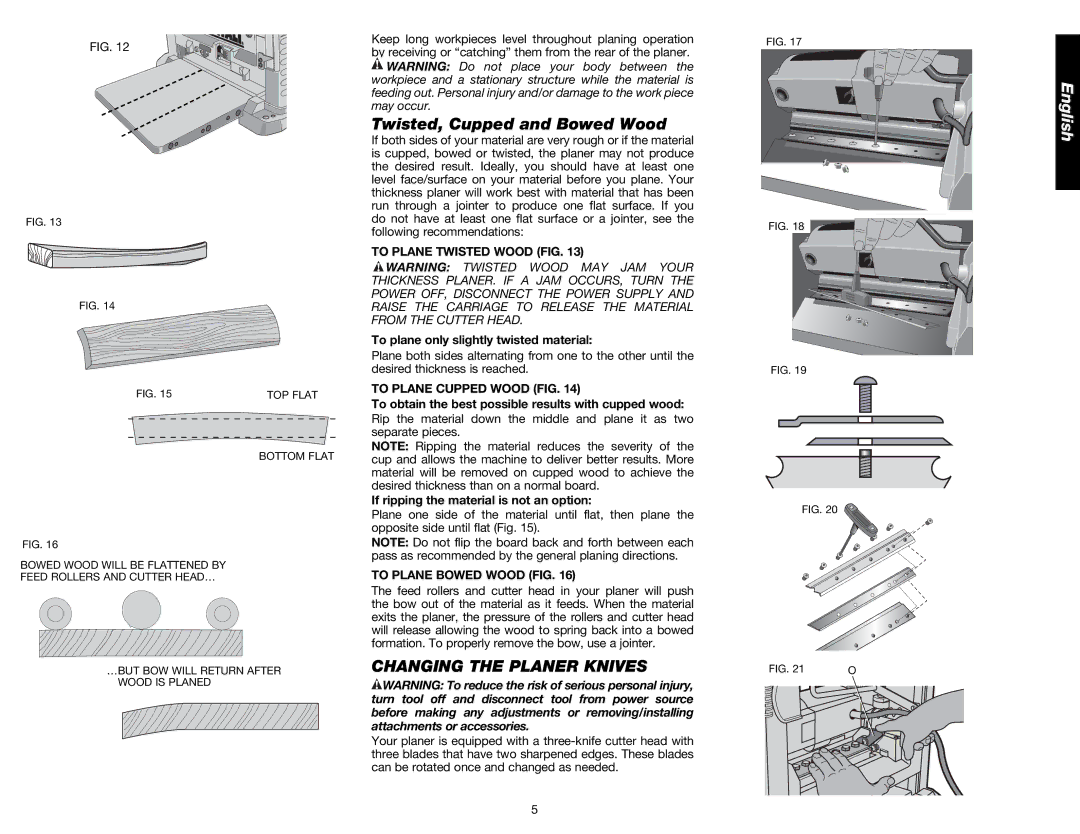
FIG. 12
Keep long workpieces level throughout planing operation by receiving or “catching” them from the rear of the planer.
![]() WARNING: Do not place your body between the workpiece and a stationary structure while the material is feeding out. Personal injury and/or damage to the work piece may occur.
WARNING: Do not place your body between the workpiece and a stationary structure while the material is feeding out. Personal injury and/or damage to the work piece may occur.
Twisted, Cupped and Bowed Wood
FIG. 17
English
FIG. 13
FIG. 14
FIG. 15
FIG. 16
BOWED WOOD WILL BE FLATTENED BY FEED ROLLERS AND CUTTER HEAD…
TOP FLAT
BOTTOM FLAT
If both sides of your material are very rough or if the material is cupped, bowed or twisted, the planer may not produce the desired result. Ideally, you should have at least one level face/surface on your material before you plane. Your thickness planer will work best with material that has been run through a jointer to produce one flat surface. If you do not have at least one flat surface or a jointer, see the following recommendations:
TO PLANE TWISTED WOOD (FIG. 13)
![]() WARNING: TWISTED WOOD MAY JAM YOUR THICKNESS PLANER. IF A JAM OCCURS, TURN THE POWER OFF, DISCONNECT THE POWER SUPPLY AND RAISE THE CARRIAGE TO RELEASE THE MATERIAL FROM THE CUTTER HEAD.
WARNING: TWISTED WOOD MAY JAM YOUR THICKNESS PLANER. IF A JAM OCCURS, TURN THE POWER OFF, DISCONNECT THE POWER SUPPLY AND RAISE THE CARRIAGE TO RELEASE THE MATERIAL FROM THE CUTTER HEAD.
To plane only slightly twisted material:
Plane both sides alternating from one to the other until the desired thickness is reached.
TO PLANE CUPPED WOOD (FIG. 14)
To obtain the best possible results with cupped wood:
Rip the material down the middle and plane it as two separate pieces.
NOTE: Ripping the material reduces the severity of the cup and allows the machine to deliver better results. More material will be removed on cupped wood to achieve the desired thickness than on a normal board.
If ripping the material is not an option:
Plane one side of the material until flat, then plane the opposite side until flat (Fig. 15).
NOTE: Do not flip the board back and forth between each pass as recommended by the general planing directions.
TO PLANE BOWED WOOD (FIG. 16)
The feed rollers and cutter head in your planer will push the bow out of the material as it feeds. When the material exits the planer, the pressure of the rollers and cutter head will release allowing the wood to spring back into a bowed formation. To properly remove the bow, use a jointer.
FIG. 18 |
FIG. 19
FIG. 20
…BUT BOW WILL RETURN AFTER WOOD IS PLANED
CHANGING THE PLANER KNIVES
![]() WARNING: To reduce the risk of serious personal injury, turn tool off and disconnect tool from power source before making any adjustments or removing/installing attachments or accessories.
WARNING: To reduce the risk of serious personal injury, turn tool off and disconnect tool from power source before making any adjustments or removing/installing attachments or accessories.
Your planer is equipped with a
FIG. 21 | O |
5
